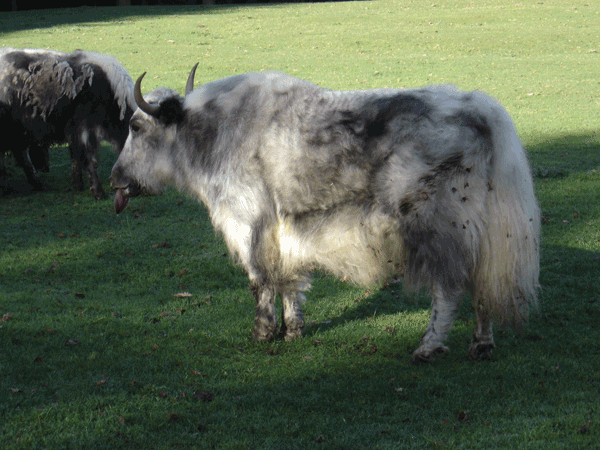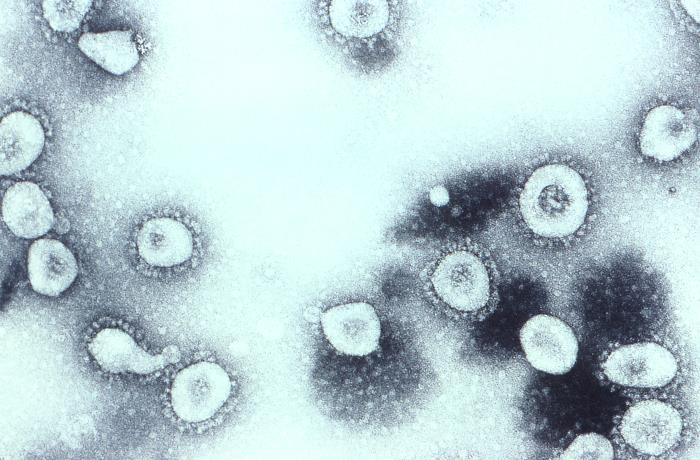|
Animal Virology
Veterinary virology is the study of viruses in non-human animals. It is an important branch of veterinary medicine. Rhabdoviruses Rhabdoviruses are a diverse family of single stranded, negative sense RNA viruses that infect a wide range of hosts, from plants and insects, to fish and mammals. The ''Rhaboviridae'' family consists of six genera, two of which, cytorhabdoviruses and nucleorhabdoviruses, only infect plants. Novirhabdoviruses infect fish, and vesiculovirus, lyssavirus and ephemerovirus infect mammals, fish and invertebrates. The family includes pathogens such as rabies virus, vesicular stomatitis virus and potato yellow dwarf virus that are of public health, veterinary, and agricultural significance. Foot-and-mouth disease virus Foot-and-mouth disease virus (FMDV) is a member of the Aphthovirus genus in the Picornaviridae family and is the cause of foot-and-mouth disease in pigs, cattle, sheep and goats. It is a non-enveloped, positive strand, RNA virus. FMDV ... [...More Info...] [...Related Items...] OR: [Wikipedia] [Google] [Baidu] |
Bluetongue Virus
Bluetongue disease is a noncontagious, insect-borne, viral disease of ruminants, mainly sheep and less frequently cattle, yaks, goats, buffalo, deer, dromedaries, and antelope. It is caused by ''Bluetongue virus'' (''BTV''). The virus is transmitted by the midges '' Culicoides imicola'', '' Culicoides variipennis'', and other culicoids. Signs In sheep, BTV causes an acute disease with high morbidity and mortality. BTV also infects goats, cattle, and other domestic animals, as well as wild ruminants (for example, blesbuck, white-tailed deer, elk, and pronghorn antelope). Major signs are high fever, excessive salivation, swelling of the face and tongue, and cyanosis of the tongue. Swelling of the lips and tongue gives the tongue its typical blue appearance, though this sign is confined to a minority of the animals. Nasal signs may be prominent, with nasal discharge and stertorous respiration. Some animals also develop foot lesions, beginning with coronitis, with ... [...More Info...] [...Related Items...] OR: [Wikipedia] [Google] [Baidu] |
Equine Viral Arteritis
Equine viral arteritis (EVA) is a disease of horses caused by a virus of the species ''Alphaarterivirus equid'', an RNA virus. It is the only species in the genus ''Alphaarterivirus'', and that is the only genus in the ''Equarterivirinae'' subfamily. The virus which causes EVA was first isolated in 1953, but the disease has afflicted equine animals worldwide for centuries. It has been more common in some breeds of horses in the United States, but there is no breed "immunity". In the UK, it is a notifiable disease. There is no known human hazard. Signs The signs shown depend on the horse's age, the strain of the infecting virus, the condition of the horse and the route by which it was infected. Most horses with EVA infection do not show any signs; if a horse does show signs, these can vary greatly in severity. Following infection, the first sign is fever, peaking at , followed by various signs such as lethargy, nasal discharge, "pink eye" (conjunctivitis), swelling over the eye ... [...More Info...] [...Related Items...] OR: [Wikipedia] [Google] [Baidu] |
Bluetongue Disease
Bluetongue disease is a noncontagious, insect-borne, viral disease of ruminants, mainly sheep and less frequently cattle, yaks, goats, buffalo, deer, dromedaries, and antelope. It is caused by ''Bluetongue virus'' (''BTV''). The virus is transmitted by the midges '' Culicoides imicola'', ''Culicoides variipennis'', and other culicoids. Signs In sheep, BTV causes an acute disease with high morbidity and mortality. BTV also infects goats, cattle, and other domestic animals, as well as wild ruminants (for example, blesbuck, white-tailed deer, elk, and pronghorn antelope). Major signs are high fever, excessive salivation, swelling of the face and tongue, and cyanosis of the tongue. Swelling of the lips and tongue gives the tongue its typical blue appearance, though this sign is confined to a minority of the animals. Nasal signs may be prominent, with nasal discharge and stertorous respiration. Some animals also develop foot lesions, beginning with coronitis, with con ... [...More Info...] [...Related Items...] OR: [Wikipedia] [Google] [Baidu] |
Pandemic
A pandemic () is an epidemic of an infectious disease that has spread across a large region, for instance multiple continents or worldwide, affecting a substantial number of individuals. A widespread endemic disease with a stable number of infected individuals is not a pandemic. Widespread endemic diseases with a stable number of infected individuals such as recurrences of seasonal influenza are generally excluded as they occur simultaneously in large regions of the globe rather than being spread worldwide. Throughout human history, there have been a number of pandemics of diseases such as smallpox. The most fatal pandemic in recorded history was the Black Death—also known as The Plague—which killed an estimated 75–200 million people in the 14th century. The term had not been used then but was used for later epidemics, including the 1918 influenza pandemic—more commonly known as the Spanish flu. Current pandemics include HIV/AIDS and COVID-19. Definition A pa ... [...More Info...] [...Related Items...] OR: [Wikipedia] [Google] [Baidu] |
Influenza
Influenza, commonly known as "the flu", is an infectious disease caused by influenza viruses. Symptoms range from mild to severe and often include fever, runny nose, sore throat, muscle pain, headache, coughing, and fatigue. These symptoms begin from one to four days after exposure to the virus (typically two days) and last for about 2–8 days. Diarrhea and vomiting can occur, particularly in children. Influenza may progress to pneumonia, which can be caused by the virus or by a subsequent bacterial infection. Other complications of infection include acute respiratory distress syndrome, meningitis, encephalitis, and worsening of pre-existing health problems such as asthma and cardiovascular disease. There are four types of influenza virus, termed influenza viruses A, B, C, and D. Aquatic birds are the primary source of Influenza A virus (IAV), which is also widespread in various mammals, including humans and pigs. Influenza B virus (IBV) and Influenza C virus (ICV) ... [...More Info...] [...Related Items...] OR: [Wikipedia] [Google] [Baidu] |
Orthomyxoviridae
''Orthomyxoviridae'' (from Greek ὀρθός, ''orthós'' 'straight' + μύξα, ''mýxa'' 'mucus') is a family of negative-sense RNA viruses. It includes seven genera: '' Alphainfluenzavirus'', '' Betainfluenzavirus'', '' Gammainfluenzavirus'', '' Deltainfluenzavirus'', '' Isavirus'', '' Thogotovirus'', and '' Quaranjavirus''. The first four genera contain viruses that cause influenza in birds (see also avian influenza) and mammals, including humans. Isaviruses infect salmon; the thogotoviruses are arboviruses, infecting vertebrates and invertebrates (such as ticks and mosquitoes). The Quaranjaviruses are also arboviruses, infecting vertebrates (birds) and invertebrates (arthropods). The four genera of Influenza virus that infect vertebrates, which are identified by antigenic differences in their nucleoprotein and matrix protein, are as follows: * '' Alphainfluenzavirus'' infects humans, other mammals, and birds, and causes all flu pandemics * '' Betainfluenzavirus'' ... [...More Info...] [...Related Items...] OR: [Wikipedia] [Google] [Baidu] |
Influenza
Influenza, commonly known as "the flu", is an infectious disease caused by influenza viruses. Symptoms range from mild to severe and often include fever, runny nose, sore throat, muscle pain, headache, coughing, and fatigue. These symptoms begin from one to four days after exposure to the virus (typically two days) and last for about 2–8 days. Diarrhea and vomiting can occur, particularly in children. Influenza may progress to pneumonia, which can be caused by the virus or by a subsequent bacterial infection. Other complications of infection include acute respiratory distress syndrome, meningitis, encephalitis, and worsening of pre-existing health problems such as asthma and cardiovascular disease. There are four types of influenza virus, termed influenza viruses A, B, C, and D. Aquatic birds are the primary source of Influenza A virus (IAV), which is also widespread in various mammals, including humans and pigs. Influenza B virus (IBV) and Influenza C virus (ICV) ... [...More Info...] [...Related Items...] OR: [Wikipedia] [Google] [Baidu] |
Gastroenteritis
Gastroenteritis, also known as infectious diarrhea and gastro, is an inflammation of the gastrointestinal tract including the stomach and intestine. Symptoms may include diarrhea, vomiting, and abdominal pain. Fever, lack of energy, and dehydration may also occur. This typically lasts less than two weeks. It is not related to influenza, even though in the U.S. it is sometimes called the "stomach flu". Gastroenteritis is usually caused by viruses; however, gut bacteria, parasites, and fungi can also cause gastroenteritis. In children, rotavirus is the most common cause of severe disease. In adults, norovirus and ''Campylobacter'' are common causes. Eating improperly prepared food, drinking contaminated water or close contact with a person who is infected can spread the disease. Treatment is generally the same with or without a definitive diagnosis, so testing to confirm is usually not needed. For young children in impoverished countries, prevention includes hand washing with s ... [...More Info...] [...Related Items...] OR: [Wikipedia] [Google] [Baidu] |
Vertebrates
Vertebrates () comprise all animal taxa within the subphylum Vertebrata () ( chordates with backbones), including all mammals, birds, reptiles, amphibians, and fish. Vertebrates represent the overwhelming majority of the phylum Chordata, with currently about 69,963 species described. Vertebrates comprise such groups as the following: * jawless fish, which include hagfish and lampreys * jawed vertebrates, which include: ** cartilaginous fish (sharks, rays, and ratfish) ** bony vertebrates, which include: *** ray-fins (the majority of living bony fish) *** lobe-fins, which include: **** coelacanths and lungfish **** tetrapods (limbed vertebrates) Extant vertebrates range in size from the frog species '' Paedophryne amauensis'', at as little as , to the blue whale, at up to . Vertebrates make up less than five percent of all described animal species; the rest are invertebrates, which lack vertebral columns. The vertebrates traditionally include the hagfish, wh ... [...More Info...] [...Related Items...] OR: [Wikipedia] [Google] [Baidu] |
Coronaviridae
''Coronaviridae'' is a family of enveloped, positive-strand RNA viruses which infect amphibians, birds, and mammals. The group includes the subfamilies '' Letovirinae'' and ''Orthocoronavirinae;'' the members of the latter are known as coronaviruses. The viral genome is 26–32 kilobases in length. The particles are typically decorated with large (~20 nm), club- or petal-shaped surface projections (the " peplomers" or "spikes"), which in electron micrographs of spherical particles create an image reminiscent of the solar corona. Virology The 5' and 3' ends of the genome have a cap and poly(A) tract, respectively. The viral envelope, obtained by budding through membranes of the endoplasmic reticulum (ER) or Golgi apparatus, invariably contains two virus-specified glycoprotein species, known as the spike (S) and membrane (M) proteins. The spike protein makes up the large surface projections (sometimes known as peplomers), while the membrane protein is a triple-spanni ... [...More Info...] [...Related Items...] OR: [Wikipedia] [Google] [Baidu] |
Torovirus
''Torovirus'' is a genus of enveloped, positive-strand RNA viruses in the order ''Nidovirales'' and family ''Tobaniviridae''. They primarily infect vertebrates, especially cattle, pigs, and horses. Diseases associated with this genus include gastroenteritis, which commonly presents in mammals. ''Torovirus'' is the only genus in the monotypic subfamily ''Torovirinae''. ''Torovirus'' is also a monotypic taxon, containing only one subgenus, ''Renitovirus''. The discovery of the first torovirus can be traced back to 1970s. Equine torovirus (EToV) was accidentally found in the rectal sample from a horse who was experiencing severe diarrhea. The 'Breda' bovine torovirus was later found in 1979 while investigation in a dairy farm in Breda. They had several calves experiencing severe diarrhea for months. In 1984, torovirus-like particles were detected with electron microscope (EM) technique in the human patients with gastroenteritis.Cho, K. O., & Hoet, A. E. (2014). Toroviruses (Co ... [...More Info...] [...Related Items...] OR: [Wikipedia] [Google] [Baidu] |
Coronavirus
Coronaviruses are a group of related RNA viruses that cause diseases in mammals and birds. In humans and birds, they cause respiratory tract infections that can range from mild to lethal. Mild illnesses in humans include some cases of the common cold (which is also caused by other viruses, predominantly rhinoviruses), while more lethal varieties can cause SARS, MERS and COVID-19, which is causing the ongoing pandemic. In cows and pigs they cause diarrhea, while in mice they cause hepatitis and encephalomyelitis. Coronaviruses constitute the subfamily ''Orthocoronavirinae'', in the family '' Coronaviridae'', order ''Nidovirales'' and realm ''Riboviria''. They are enveloped viruses with a positive-sense single-stranded RNA genome and a nucleocapsid of helical symmetry. The genome size of coronaviruses ranges from approximately 26 to 32 kilobases, one of the largest among RNA viruses. They have characteristic club-shaped spikes that project from their surface, which ... [...More Info...] [...Related Items...] OR: [Wikipedia] [Google] [Baidu] |



.jpg)





